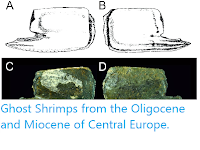Leptostracan Crustaceans are small, filter feeding Arthropods found from the intertidal zone to the abyssal ocean plains, though most are found at depths of less than 200 m. They are a small group, with less than 50 known extant species and a very limited fossil record. However, they are considered to be the most primitive, and therefore earliest appearing, members of the Malacostra, the wider group that also includes major Crustacean groups such as the Decapods, Amphipods and Isopods, making their evolutionary history very interesting to palaeobiologists.
In a paper published in the Proceedings of the Royal Society Series B: Biological Sciences on 22 March 2017, David Siveter of the Department of Geology at the University of Leicester, Derek Briggs of the Department of Geology and Geophysics and Yale Peabody Museum of Natural History at Yale University, Derek Siveter of Earth Collections at the University Museum of Natural History in Oxford and the Department of Earth Sciences at the University of Oxford, Mark Sutton of the Department of Earth Sciences and Engineering at Imperial College London and David Legg, also of the Department of Earth Sciences at the University of Oxford, describe a new species of Leptostracan Crustacean from the Silurian Herefordshire Lagerstätte.
The Herefordshire Lagerstätte comprises a large number of small (at most
centimetres) organisms from the Middle Silurian (about 425 million
years ago). The organisms are preserved in three dimensions within
calcareous nodules within a layer of volcaniclastic sediments (i.e. a
volcanic ashfall in a marine environment), and can only be accessed
using computerised tomography scanning techniques. Brachioods,
Polychaete Worms, Gastropods, Aplacophorans, Chelicerates,
Marrellomorphs, Mandibulates, Barnacles, Phyllocarids, Ostracods,
Starfish and Sponges have all been found in the Herefordshire
Lagerstätte; together these are known as the Herefordshire Biota.
The new species is named Cascolus ravitis, in honour of naturalist and broadcaster David Attenborough; Cascolus derived from the Latin for dweller in a fortified building (the Middle English meaning of Attenborough), while ravitis derives from Ratae (the Latin name of Leicester, where Attenborough grew up), vita (Latin for life) and commeatis (Latin for messenger). It is described from a single specimen 8.9 mm in length, preserved within a calcareous nodule in three dimensions with soft tissue intact, following serial grinding at 20 μm intervals and reconstruced as a three dimensional model using the SPIERS software suite which enables reconstruction and analysis of tomographic (serial image) datasets, such as those obtained from serial-grinding of specimens, or from CT scanning.
Cascolus ravitis has a head with five pairs of appendages and a head shield, followed by nine limb-bearing segments then two (probably) limbless segments. The head shield is smooth and elongate, with a ridge running between the eyes. All limbs except the first are biramous (split in two).
See also...
The new species is named Cascolus ravitis, in honour of naturalist and broadcaster David Attenborough; Cascolus derived from the Latin for dweller in a fortified building (the Middle English meaning of Attenborough), while ravitis derives from Ratae (the Latin name of Leicester, where Attenborough grew up), vita (Latin for life) and commeatis (Latin for messenger). It is described from a single specimen 8.9 mm in length, preserved within a calcareous nodule in three dimensions with soft tissue intact, following serial grinding at 20 μm intervals and reconstruced as a three dimensional model using the SPIERS software suite which enables reconstruction and analysis of tomographic (serial image) datasets, such as those obtained from serial-grinding of specimens, or from CT scanning.
Holotype of Cascolus ravitis, exoskeleton and soft parts (OUMNH C.29698): (a–u) ‘virtual’ reconstructions (a,b,f,h–k,m–u are stereo-pairs); (v) specimen in rock. The exact boundary between structures such as body and limbs, as indicated by colour changes, is somewhat arbitrary. (a) Dorsal view. (b) Ventral view. (c) Anterior part of head, appendages omitted, ventral view. (d ) Posterior part of trunk, appendages omitted, ventral view. (e) Right lateral view. (f ) Part of trunk, dorsal view. (g) Head and most of the trunk, appendage 1 omitted, posterodorsal view. (h) Head with appendages and trunk segments 1 and 2 with appendages omitted; ventral view. (i) Anteroventral view. ( j ) Limb base and proximal part of antennules, right ventral oblique view. (k) Antennae, right anteroventral oblique view. (l ) Anterolateral view. (m,n) Mandible, left limb: posterior oblique (m) and right anteroventral oblique (n) views. (o) Maxillula, left limb, posterior oblique view. ( p) Sternites 3–6, anteroventral view, appendages omitted. (q) Maxilla, left limb, posterior oblique view. (r–t) Trunk appendage 2, left limb: gnathobase (r) and complete limb (s) posterior oblique views; and inner proximal part of endopod (t) posterior oblique medial view. (u) Trunk appendage 5, left limb, posterior oblique view. ai, axial inflation; as?, apodous segments?; ba, basipod; bi, bell-shaped inflation; e1, e2, epipods; en, endopod; ex, exopod; f1–f3, flagella; fu, furrow; hi, indentation in anterior margin of the head shield; gn, coxal gnathobase; h1–h5, head appendages; hr, half-ring of trunk tergite; ie, inflation adaxially forward of each eye (‘eye ridge’); la, labrum; lb, limb base; no, node; or, occipital ring; pa, precoxal area; pe, pedunculate eye; t1–t9, trunk appendages; te, end of the trunk, masked by extraneous matter; tr, trunk; tu, tubercle(s). Numbers refer to trunk segments and trunk tergites/sternites as appropriate. Arrows in (m-o, t) indicate podomere boundaries. Arrow in (s,u) indicates a spine/seta. Scale bars: (a–q), (s–v) are 0.5 mm; (r) is 0.1 mm. Siviter et al. (2017).
Cascolus ravitis has a head with five pairs of appendages and a head shield, followed by nine limb-bearing segments then two (probably) limbless segments. The head shield is smooth and elongate, with a ridge running between the eyes. All limbs except the first are biramous (split in two).
See also...
Follow Sciency Thoughts on Facebook.







